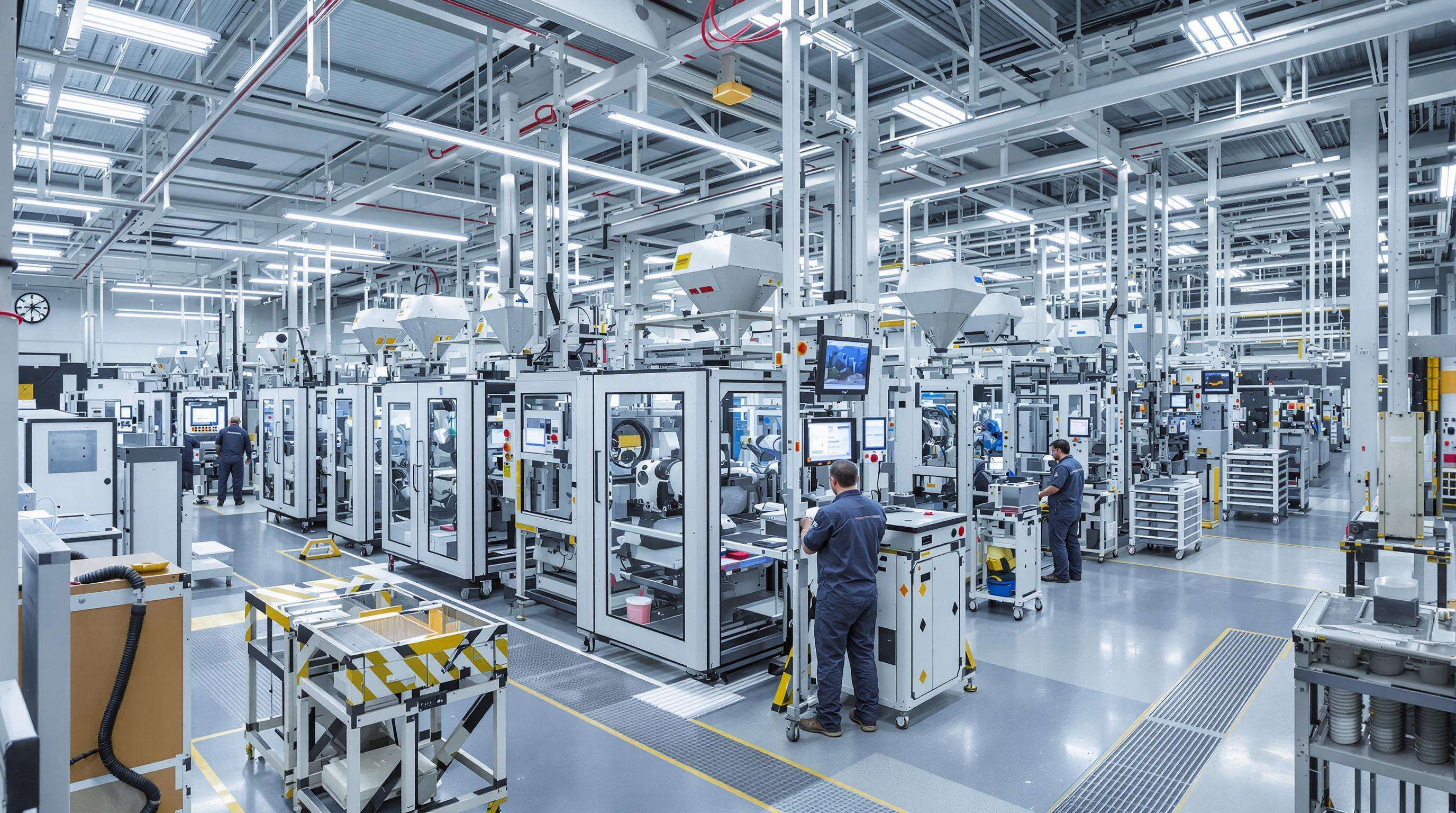هناك ثلاثة عوامل تُسهم في زيادة استخدام صب الحقن في صناعة السيارات: الضغط من أجل تخفيف وزن المركبات بسبب اللوائح التنظيمية، والميزة المتعلقة بالتكلفة والأداء مقارنة بطرق التشغيل المعتمدة على المعادن، وزيادة التصنيع على نطاق واسع لإنتاج المركبات الكهربائية (EV). وبما أن مصنعي السيارات يعملون على خفض وزن المركبات بنسبة تتراوح بين 10% إلى 15% لمواكبة أهداف الانبعاثات لعام 2025، فقد استُبدلت خزانات الوقود والأنابيب الهوائية وآبار السوائل المعدنية بنسخ مصنوعة من البلاستيك. وقد أدت هذه الانتقالات إلى استبدال ما كان يمثل 30% من السيارات ذات الفئة المتوسطة. ويسمح هذا التحوّل بتحقيق وفر في الوزن يتراوح بين 80 إلى 120 كجم لكل مركبة، ويمكن الحفاظ على هذا الوفـر من خلال تحقيق سلامة الاصطدام باستخدام خلطات البوليمر الحديثة.
كما أن الثورة المستمرة في المركبات الكهربائية تُسهم في دفع الطلب، حيث تحتاج أغطية البطاريات وأنظمة إدارة الحرارة إلى هندسات بلاستيكية خفيفة الوزن ومقاومة للتآكل لا يمكن إنتاجها باستخدام صب الحقن. وبحسب استطلاع أُجري في 2024، فإن 78% من منصات المركبات الكهربائية تضم أجزاءً مصنوعة بالتفجير في خطوط تبريد البطاريات والتجميعات الخاصة بأنظمة التهوية وتكييف الهواء (HVAC). وجعلت الاختراقات في المواد، مثل مادة البولي إيثيلين تيريفثاليت (PET) المدعمة بـ 35% من الألياف الزجاجية، هذه الأجزاء قادرة على تحمل درجات حرارة متزايدة تتجاوز 200°م، إضافة إلى توفير 40% في الوزن مقارنة بالإصدارات المصنوعة من الألومنيوم.
كما تُسهم الديناميكيات المتعلقة بالتكاليف في دفع عملية التبني. تتراوح تكاليف الجزء الواحد في صناعة التفجير بين 1.20 و4.50 دولار أمريكي للقطع ذات الإنتاج الكثيف، مقارنةً بـ 8 إلى 15 دولاراً للبدائل المصنوعة من المعدن المشكل بـ 60% أقل في تكاليف أدوات القوالب. ويستفيد الموردون من هذه الاعتبارات الاقتصادية لتطبيق استراتيجيات إنتاج متعددة المناطق، حيث يمتلك 18 من أصل 20 مورداً عالمياً رائداً عمليات تصنيع متزامنة باستخدام تقنية التفجير في أمريكا الشمالية وأوروبا وآسيا لتقليل تكاليف النقل.

لا يمكن تحقيق القولبة بالنفخ ذات التكلفة الفعالة إلا من خلال التحكم الدقيق في استخدام المواد ووقت الدورة والاستهلاك الكهربائي. تتيح قياسية هذه الركائز للمصنّعين توسيع الإنتاج مع الحفاظ على سلامة القطعة. تشير التحليلات الصناعية إلى أنه عندما تقوم المصانع بتطبيق هذه الأنظمة مجتمعة (بدلاً من تطبيقها بشكل منفصل)، تنخفض التكاليف بنسبة تتراوح بين 18٪ و27٪. هذا النهج يحوّل العمليات الفردية إلى شبكات إنتاج متكاملة جيدًا تعتمد على ثلاثة مقاربات أساسية.
تقلل البرمجة الدقيقة للparison من فقدان الراتنج أثناء عملية البثق وتحافظ على اتساق سماكة الجدران. تعمل الخوارزميات المحسّنة على تكييف توزيع المادة مع هندسة القالب، مما يقلل الهالك بنسبة تتراوح بين 15 و22% في العمليات الدفعية. (وفقًا لوظيفة الجزء) يحافظ مستوى محسوب يتراوح بين 25 و40% من البوليمرات المعاد تدويرها على المواصفات الإنشائية، مع خفض تكلفة المواد الخام الداخلة. يعد تحليل العناصر المحدودة لتوفير الوزن خيارًا إضافيًا لتحقيق توفير في استهلاك الطاقة دون التأثير على أداء اختبار التصادم.
نظام المياه المضطربة لإخراج المنتجات يقلل من مراحل التصلب بـ30 إلى 40 ثانية لكل دورة. تقلل عمليات الإخراج المزدوج والضغط من وقت التوقف في القطع الأكبر حجمًا مثل قنوات التهوية أو الخزانات. وبالإضافة إلى ذلك، تتصل عمليات التشذيب التلقائية داخل القالب مباشرةً بأنظمة النقل وتوفر معدل توفر يبلغ 97% خلال فترات التشغيل المستمر. يتم تعديل معايير البثق تلقائيًا في الوقت الفعلي كجزء من نظام التحكم لمراقبة اللزوجة لتجنب الرفض دون إيقاف الخط.
تُنسق أطر المعايير ISO 50001 تشغيل المحركات والمسخّنات عبر الشبكات متعددة المصانع. تقلل أنظمة الهجين المؤازرة الهيدروليكية من استهلاك الطاقة بنسبة تتراوح بين 45-60% مقارنةً بالأنظمة الهيدروليكية عند التشكيل بمستويات طاقة منخفضة (غير الذروة). ستكشف عمليات تدقيق التصوير الحراري عن فجوات في عزل البراميل، مما يقلل بشكل كبير من خسائر الطاقة في وضع الاستعداد. تستعيد الأنظمة المتكاملة لمصنع استعادة الحرارة الطاقة المهدرة لاستخدامها في العمليات الثانوية، ما ساهم في تحسين بنسبة 35% في استخدام الكيلوواط ساعة لكل قطعة منذ عام 2022.

يمكن أن يختلف تحدي الجودة المتسقة من عملية صب نفخ واحد إلى آخر بين عمليات الصب النفخي العاملة في مناطق جغرافية مختلفة. في الوقت نفسه، يمكن أن تؤدي العوامل البيئية مثل درجة الحرارة والرطوبة إلى تغيير لزوجة المادة، مما يؤدي إلى اختلافات في سماكة الجدران والعيوب الهيكلية. كما يمكن أن تؤدي عدم وجود طرق موحدة للقياس وأجهزة فحص معايرة إلى زيادة معدلات الفاقد بنسبة تتراوح بين 18 و22%. إن هذا الذهن النوعي يوفر اكتشافًا فوريًا للحالات الشاذة على الأنظمة الرقمية للجودة مع إطارات تصنيف العيوب المتكاملة. ومع ذلك، فإن ظروف الشهادات الإقليمية المتباينة تجعل معايرة قيم العتبات أمراً معقداً، وهنا نحتاج إلى نماذج التعلم الآلي لتوحيد مؤشرات المؤشر الكيفي (QI) مع أخذ القيود المحلية بعين الاعتبار.
تؤدي مزامنة خطة تدفق المواد وتخصيص القوالب، وترتيبات الصيانة الخاصة بتشغيل مثل هذه العمليات عبر عدد من المصانع إلى إضافة تعقيد للدوائر الضيقة. وقد تأجل شحن البضائع بين مصنع وآخر، مما يؤخر بالتالي تسليم الراتنج بطريقة الدقة في الوقت المناسب، كما تضيف الإجراءات الجمركية ما بين 30 إلى 45 يومًا إلى فترة التسليم عند نقل المعدات بين المصانع. تخفف أدوات التخطيط للموارد المركزية من هذه التحديات من خلال الشفافية التي توفرها فيما يتعلق بمعدلات استخدام المعدات والسجلات المتعلقة بالصيانة التنبؤية. ويعتبر الفارق الموجود بين المناطق من حيث المهارات البشرية حاجزاً آخر أمام التوحيد القياسي - فمثلاً، قد تقوم مجموعة من الفنيين المتخصصين في تعديل القوالب بأداء عمليات التغيير بشكل مختلف عن مجموعة أخرى من الفنيين. إن التدريب الاستباقي للمشغلين باستخدام أنظمة الواقع الافتراضي هو المفتاح لتحقيق التوازن وسد فجوة الكفاءة، حيث أظهرت الدراسات المقارنة انخفاضاً بنسبة 27% في التباين أثناء عمليات الإعداد.
تواجه عمليات القولبة بالنفخ طلبات متزايدة لتحقيق إنتاج اقتصادي وتحسين أداء القطع. إن هذا التناقض ناتج عن متطلبات متعارضة تتمثل في تقليل استخدام المواد وأوقات الدورة، وفي الوقت نفسه ضمان سلامة هيكلية في مجموعة واسعة من التطبيقات automotive. هناك ثلاثة مقايضات مهمة يجب على المصنعين التعامل معها للتوازن بين الجدوى الاقتصادية والمواصفات الفنية.
يبقى تحسين سمك الجدار تحديًا رئيسيًا، إذ يمكن أن تؤدي تخفيضات بحجم 0.2 مم إلى خفض تكاليف المواد بنسبة 18٪، لكنها قد تُضعف مقاومة الصدمات. تتيح الآن برامج المحاكاة المتقدمة للتدفق للمهندسين التنبؤ بتجمعات الإجهاد في الهندسات المعقدة، مما يسمح بضبط السمك بدقة. تشير البيانات الميدانية الحديثة إلى:
| نطاق السماكة | نسبة العيوب % | وفر بالوزن % |
|---|---|---|
| 2.5-3.0 مم | 2.1 | 0 |
| 2.0-2.4 مم | 5.8 | 12 |
| 1.5-1.9 مم | 15.4 | 27 |
المصدر: تقرير متانة مكونات السيارات لعام 2024
بينما تقلل أنظمة الروبوتات من تكاليف العمالة بنسبة 34٪ في السيناريوهات ذات الحجم العالي، ينخفض العائد على الاستثمار (ROI) إلى أقل من 50,000 وحدة سنويًا. كشف استطلاع أجرته شركة SME عام 2023 أن 68٪ من الشركات المصنعة تؤجل الأتمتة بسبب:
إن البنية التحتية للأتمتة الوحدية تتيح الآن تنفيذًا تدريجيًا، مع خفض تكاليف نشر المعدات مرة أخرى بنسبة 60٪ مقارنةً بالحلول المخصصة بفضل الطراز الموحّد للمعدات الطرفية.
يسمح هذا النظام المركزي لمراقبة المرافق بمراقبة عمليات التشكيل بالنفخ في الوقت الفعلي عبر عدة مرافق. عندما تتصل أجهزة الاستشعار المستندة إلى إنترنت الأشياء بالتحليلات القائمة على السحابة، يمكن للمصنّعين تحقيق كشف عن الشذوذ أسرع بنسبة 15–20% مقارنةً بالنظم المعزولة. يتيح هذا التطبيق تحكمًا عالميًا في الضغط ودرجة الحرارة وزمن الدورة، بالإضافة إلى تحكم محلي في الضغط ودرجة الحرارة وزمن الدورة لвязكية المادة. كما يوفّر مشغلي المعدات إمكانية مراقبة الانحرافات من خلال شاشة واحدة عند تجاوز ±2.5 بالمئة من مؤشرات الأداء الرئيسية الأساسية، مما يمكّن من التدخل الوقائي دون تجاوز حدود الجودة.
يعتمد تبادل المعرفة بشكل فعال عبر المصانئ الموزعة على ثلاثة أسوار:
أظهرت دراسة صناعية عبر القطاعات لعام 2024 أن المؤسسات التي تتبع بروتوكولات منظمة لتبادل المعرفة تمكنت من خفض معدلات الهدر بنسبة 18% خلال عمليات إطلاق المنتجات الجديدة، مقارنةً بالمنشآت العاملة بشكل معزول.
الأنظمة الوحدية للقوالب تحقق تغييرات أسرع بنسبة 40–60% من خلال:
خفضت هذه البروتوكولات متوسط مدة تغيير القوالب من 78 دقيقة إلى 32 دقيقة في التجارب متعددة المصانع، مما سمح بتقليل حجم الدفعات دون التأثير على مؤشر الكفاءة الشاملة للمعدات (OEE).
تتيح عملية شراء المواد الخام الموحّدة عبر 8+ منشآت تحقيق خصومات على الكميات تصل إلى 12–15% على صعيد راتنجات البوليمر. وتحسّن برامج المؤهلات المركزية من:
أدى هذا النهج إلى تقليل التوقفات المتعلقة بالمواد بنسبة 23% في التنفيذ المتعدد السنوات، مع الحفاظ على معايير الأيزو AS9100 الخاصة بالصناعة الجوية عبر جميع المصانع المشاركة.
قولبة النفخ هي عملية تصنيع تُستخدم لإنتاج أجزاء بلاستيكية مجوفة عن طريق نفخ أنبوب بلاستيكي مسخّن حتى يأخذ شكل القالب.
تُفضَّل قولبة النفخ في الإنتاج automotive لخصائصها الخفيفة ومزاياها الاقتصادية مقارنةً بالطرق التقليدية في معالجة المعادن.
يساهم قولبة النفخ في إنتاج المركبات الكهربائية من خلال توفير أجزاء خفيفة الوزن ومقاومة للتآكل، وهي ضرورية لصناديق البطاريات وأنظمة إدارة الحرارة.

حقوق النشر © 2024 شركة تشانغتشو بينغهينغ لقطع غيار السيارات المحدودة